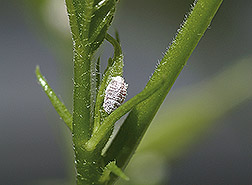Orchids on Reunion Island in the Indian Ocean are pollinated by nocturnal crickets, according to scientists who took night-vision video of the flowers. It’s the first time an insect from the cricket order has been identified as a pollinator. The raspy cricket’s head is just the right size to reach into the flower’s nectar spur. — by T.A. Frail, Megan Gambino, Abigail Tucker and Sarah Zielinski – Smithsonian magazine, March 2010
by Susan Taylor
Originally published in BellaOnline
 Mealy bugs are one of the more serious of pests on orchids, fortunately they are less likely to appear in orchid collections. They are closely related to scale and are very similar in appearance to the juvenile form of that insect. Mealy bugs are somewhat larger and often have a slight yellowish or pinkish coloring both in the adults and the newly hatched insects. The adults do not have the hard shell of scales and are easier to kill.
Mealy bugs are one of the more serious of pests on orchids, fortunately they are less likely to appear in orchid collections. They are closely related to scale and are very similar in appearance to the juvenile form of that insect. Mealy bugs are somewhat larger and often have a slight yellowish or pinkish coloring both in the adults and the newly hatched insects. The adults do not have the hard shell of scales and are easier to kill.
They prefer to eat on roots deep in the media and are often only discovered when orchids are repotted although they will also attack other parts of the plant, especially under the leaves. They will also hide in depressions on pots, in sheaths and in newly emerging growth.
Prevention of the pests is based on the life cycle. The eggs are protected by a coated egg sac and hatch in approximately 10 days. The nymphs, or juveniles, are extremely mobile and will move among plants through direct movement, dispersal through wind or air movement, and by dropping from higher areas to lower plants. They will feed on a wide variety of hosts, only one of which is orchids. Infestations are often from insects on non-orchid plants which migrate. They usually have one or two egg laying cycles per season and will continue to do so in a protected indoor area such as a greenhouse.
It is very important to immediately start intervention as soon as these pests are spotted or they will spread rapidly and can overtake a collection in a matter of weeks. The short life cycle requires that treatments be applied multiple times at approximately 10 day intervals. For visible infestations on the underside of leaves, rubbing alcohol can be used or a spray with Neem Oil and some detergent, both of which will kill the insects. I prefer a systemic such as Bayer Rose and Flower Insect Killer which is applied at 30 day intervals and which kills pests which suck. It will kill both scale and mealy bugs.
Some growth regulators will work on mealy bugs and are effective for long term control of the pests, but do nothing for the adults or for the infestation already weakening your plants. They are fairly effective, but expensive for the home grower. Insecticides are available to control orchids and the best way to control the pests is to use a combined approach which kills the adults and inhibits the growth of the nymphs.
When using chemical compounds, always read the directions for use carefully and follow the recommendations for use. It is rarely useful to use more than recommended or to spray more often than suggested. Be careful to spray when plants are shaded and the temperature is not too cold or too hot since it can harm your plants.